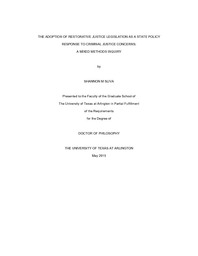
ATTENTION: The works hosted here are being migrated to a new repository that will consolidate resources, improve discoverability, and better show UTA's research impact on the global community. We will update authors as the migration progresses. Please see MavMatrix for more information.
Show simple item record
| dc.contributor.author | Sliva, Shannon Marie | en_US |
| dc.date.accessioned | 2015-07-31T22:10:18Z | |
| dc.date.available | 2015-07-31T22:10:18Z | |
| dc.date.submitted | January 2015 | en_US |
| dc.identifier.other | DISS-13162 | en_US |
| dc.identifier.uri | http://hdl.handle.net/10106/25103 | |
| dc.description.abstract | Over the past two decades, 32 states have enacted legislation supporting the use of restorative justice as crime response. The purpose of this study is to explore the contexts in which restorative justice has been adopted as a policy solution for juveniles and adults by answering the following questions: (1) Are internal characteristics of American states correlated with the adoption of restorative justice legislation between 1988 and 2014? (2) How have social, economic, political, or other factors promoted or impeded the adoption of restorative justice legislation in key states? This study uses a convergent-parallel mixed-methods approach to develop an empirically supported, contextual understanding of the state policy environments in which restorative justice policies are adopted. A quantitative cross-sectional analysis of secondary data from all 50 states uses ordinal regression to test whether hypothesized variables predict more supportive adoptions of restorative justice legislation at the state level. Concurrently, two case studies use in-depth interview methods to further explore the policy environment and the legislative decision-making process. Quantitative and qualitative data are analyzed in a convergent approach, integrating insights from both methods about the adoption of restorative justice legislation.Results indicate that social factors are more useful than economic or overt political factors in explaining the adoption of legislation to support restorative justice. More supportive restorative justice legislation in a state was predicted by a higher percentage of female legislators, a higher proportion of Black Americans, and a higher state incarceration rate. Higher crime rates slightly decreased the likelihood of more supportive adoptions. Party affiliation, state fiscal capacity, tribal populations, and victims' rights policy preferences were not predictive of more or less supportive adoptions.Case studies of legislative processes in Texas and Colorado - two states having undergone recent consideration of restorative justice bills with divergent outcomes - suggest that the legitimacy of restorative justice practices at a grassroots level, the involvement of advocacy coalitions and interest groups, and the characteristics and actions of the legislative sponsor entrusted with carrying the bill are key influences. Especially for more basic policy adoptions, these influences trump party ties and economic considerations.With the highest documented incarceration rate in the world and prisons that showcase systemic race and class disparities, the United States is at a critical junction in policymaking. This study helps decode current legislative trends and identifies pressure points that are now leading states to consider alternative forms of justice. It aids practitioners working in the justice system in understanding how they can use statutory support for restorative justice to bolster their work, and it equips policymakers and advocates with influential messages and advocacy strategies. It also suggests ways to empower marginalized voices in advocacy efforts and addresses ethical risks such as the high potential for racial disparity in selection for diversion programs like restorative justice. This study assists social workers in knowledgeably offering innovative policy solutions that best serve victims, offenders, and communities harmed by crime. | en_US |
| dc.description.sponsorship | Hegar, Rebecca L. | en_US |
| dc.language.iso | en | en_US |
| dc.publisher | Social Work | en_US |
| dc.title | The Adoption Of Restorative Justice As A State Policy Response To Criminal Justice Concerns: A Mixed Methods Inquiry | en_US |
| dc.type | Ph.D. | en_US |
| dc.contributor.committeeChair | Hegar, Rebecca L. | en_US |
| dc.degree.department | Social Work | en_US |
| dc.degree.discipline | Social Work | en_US |
| dc.degree.grantor | University of Texas at Arlington | en_US |
| dc.degree.level | doctoral | en_US |
| dc.degree.name | Ph.D. | en_US |
Files in this item
- Name:
- Sliva_uta_2502D_13162.pdf
- Size:
- 1.533Mb
- Format:
- PDF
This item appears in the following Collection(s)
Show simple item record


